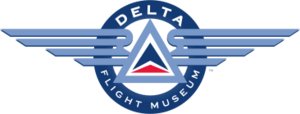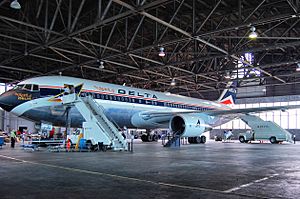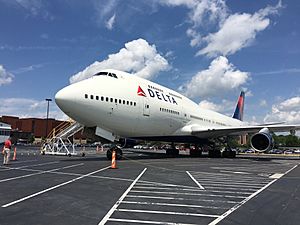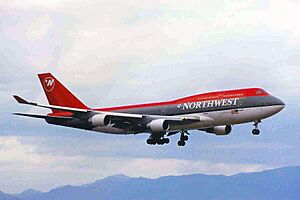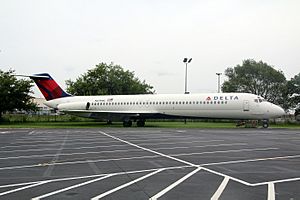Delta Flight Museum facts for kids
The Delta Flight Museum is an exciting place to visit in Hapeville, Georgia, United States. It's an aviation museum, which means it's all about airplanes and flying! You can find it close to Hartsfield–Jackson Atlanta International Airport, which is a very busy airport.
The museum is inside two old airplane hangars that were built in the 1940s. These hangars are part of Delta Air Lines' main offices. In 2011, they were even named a Historic Aerospace Site. The museum's goal is to help people from all over the world learn about the history of flight. It also celebrates the story of Delta Air Lines and its people. You can discover the future of flying here too! The museum shows the history of over 40 airlines that are part of Delta's past. It's a non-profit group, which means it relies on volunteers, donations, and money from events and gift shop sales to keep going. The museum is always growing, with new items added to its collections all the time.
The Delta Flight Museum first opened its doors to everyone in June 2014. Before that, you needed a Delta employee ID or a special appointment to visit.
Contents
How the Museum Started
The idea for a museum about Delta Air Lines began with a group of retired employees in 1990. They wanted to find one of Delta's first five Douglas DC-3 airplanes from the early 1940s. After searching, they found Delta Ship 41 in Puerto Rico. This plane was Delta's second DC-3 to carry passengers. It was being used to carry cargo at the time.
The group bought the plane and flew Ship 41 back home to Atlanta. Restoring this aircraft and bringing together old items from Delta's offices led to the creation of the museum. It was first called the Delta Air Transport Heritage Museum.
From 1995 to 1999, Ship 41 was carefully restored. Delta employees and volunteers worked hard to make it look exactly as it did when it was first delivered on January 4, 1941. Delta Ship 41 is one of the most accurately restored passenger DC-3s in the world. In 2001, it was the first aircraft to receive an award from the National Trust for Historic Preservation. Delta Ship 41 is the only original Delta passenger Douglas DC-3 still in existence. Delta Air Lines is also the only major airline known to still have its first new passenger DC-3.
On May 23, 1995, the Delta Air Transport Heritage Museum officially became a non-profit organization. This meant it was set up for public good and charity.
Historic Hangar 1: The Propeller Era
Hangar 1 is known as the "Propeller Era" hangar. Here, you can see a full-size copy of Delta's old headquarters in Monroe, Louisiana. This was Delta's main office from 1928 to 1941 before it moved to Atlanta. Hangar 1 also displays several amazing restored aircraft, including:
- Delta Ship 41: One of Delta's very first and most famous DC-3 airplanes.
- A 1931 Travel Air 6000: This plane represents the first aircraft Delta used to carry passengers.
- A replica of a Huff-Daland Duster biplane: This plane shows the first type of aircraft used by the company that came before Delta.
- A 1936 Stinson Reliant SE: This unique plane, nicknamed the "Gull Wing," was used to train pilots for Northeast Airlines in the early 1940s.
- A Northwest Airlines Waco 125: This is the only aircraft of its kind left. It's a rare version of the Waco 10 biplane.
Historic Hangar 2: The Jet Era
Hangar 2 is called the "Jet Era" hangar. It features a special plane called The Spirit of Delta. This is a Boeing 767, Delta Ship 102 (N102DA). It was the first Boeing 767-200 the company owned, bought in 1982. What's amazing is that employees, retirees, and Delta's community partners paid for it with their own donations! This effort was called Project 767. It was started by three Delta flight attendants. They wanted to show how much employees appreciated Delta's strong leadership.
This aircraft was painted with a special design and traveled around the country in 2004 to celebrate Delta's 75th birthday. The Spirit of Delta was the most important plane in Delta's fleet until March 2006. It arrived at the museum on March 3, 2006, after a final tour across the United States.
Other cool things in Hangar 2 include:
- The front part of the first Lockheed L-1011 TriStar ever built.
- The cockpit section of a Convair 880.
- The tail section of a Douglas DC-9.
- A Boeing 737 flight simulator that used to train Delta pilots. Now, you can even experience a one-hour flight in it!
Outdoor Aircraft Collection
The museum also has three other aircraft parked outside in the museum's parking lot. These include:
- A Boeing 757-200 (N608DA) painted in Delta's 1980s colors.
- A McDonnell Douglas DC-9-50 (N675MC).
- The very first Boeing 747-400 ever made for passengers, registered N661US (Ship 6301).
Delta Ship 6301 and the 747 Experience
The most important plane in the outdoor collection is Delta Ship 6301 (N661US). This was the very first Boeing 747-400 ever built! Boeing used it for flight tests first. It was then delivered to Northwest Airlines on December 8, 1989.
On October 9, 2002, N661US was flying as Northwest Airlines Flight 85. It had to make an emergency landing in Anchorage because of a problem with its rudder. It was on its way to Tokyo from Detroit.
When Northwest Airlines merged with Delta in 2009, N661US became Delta Ship 6301. It continued to carry passengers for Delta until it retired on September 9, 2015. This amazing plane flew over 61 million miles in its lifetime!
In April 2016, the huge jet was moved across two streets from the airport tarmac to its permanent spot in the museum parking lot.
Delta employees started a fundraising campaign called "The Airloom Project." Their goal was to turn Ship 6301 and the area around it into an outdoor exhibit. It's similar to The Spirit of Delta inside the museum. Visitors can enter the 747-400 using stairs and an elevator. You walk through the first-class cabin, then the economy section. Part of the economy section has been turned into an exhibit space. You can even see the back wall of the plane! Visitors can also walk on a special walkway over part of the wing, with railings for safety. The cargo hold has been emptied, and the ceiling of the cabin has been removed. This lets visitors look down from the upper deck all the way through the lower deck and cargo hold. It's a great way to see how massive the aircraft is inside!
Museum Collections and Exhibits
The museum has many interesting collections and facilities, including:
- The Spirit of Delta: Delta's first Boeing 767-200. Employees, retirees, and friends bought this plane and gave it to Delta in 1982. The back part of the plane is now an exhibit space. The cockpit, kitchen area, and first-class section are still just as they were.
- "Ship 41": The first Douglas DC-3 to carry Delta passengers. Volunteers and mechanics restored it from 1993 to 1999 after finding it in Puerto Rico. In 2001, Ship 41 was the first aircraft to receive an award from the National Trust for Historic Preservation.
- A 1931 Travel Air: This plane represents Delta's very first passenger aircraft.
- A 1936 Stinson Reliant SE: Nicknamed the "Gull Wing," this unique plane trained pilots for Northeast Airlines in the early 1940s.
- A large collection of records and items about Delta and its related airlines.
- A library with books and information about aviation.
- Different temporary exhibits that change over time.
- A 1975 McDonnell Douglas DC-9-50 (N675MC): When it retired in 2013, it was the oldest plane still flying in Delta's fleet.
- A copy of the first Delta station in Monroe, Louisiana.
- The front part of the first Lockheed L-1011 TriStar ever built. Delta used to fly almost 60 of these planes.
- Delta Ship 6301 (N661US): This plane retired on September 9, 2015. It had been flying since December 8, 1989, with Northwest Airlines. It was the first Boeing 747-400 ever built and was the prototype aircraft. This was also the plane involved in an incident in 2002 as Northwest Airlines Flight 85.
- A 1985 Boeing 757-200 (N608DA).
- A 1957 Douglas DC-7B (N4887C).
See also


